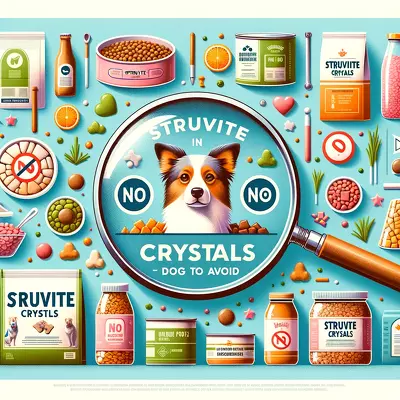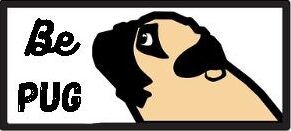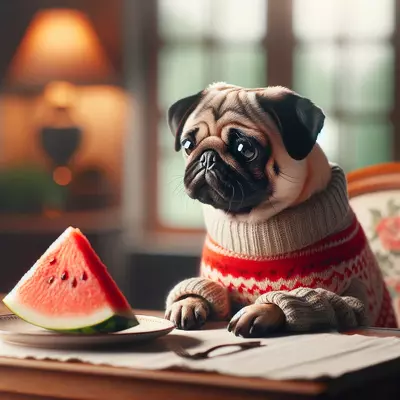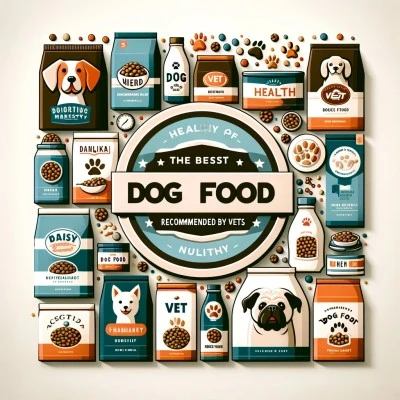Feeding Fido Right: The Mystery of Struvite Crystals in Dogs Foods to Avoid Unraveled

Struvite crystals in dogs can lead to urinary issues. Diet plays a crucial role in preventing these formations. This article will delve into the foods dog owners should sidestep to maintain a crystal-free urinary tract for their furry companions. By understanding these dietary culprits, one can minimize struvite-related concerns.
I. Introduction
A. Crystals and Canines: A Tangle in the Tapestry of Health
Every dog owner wishes their furry friend to lead a life full of wagging tails and boundless energy. However, unforeseen health challenges like struvite crystals can threaten this joyful picture. These minuscule, needle-like formations in a dog’s urinary system might sound like a rare problem, but they’re more common than one might think. While various factors can lead to the development of these crystals, one major contributor is often lurking right in our pet’s bowl: their diet.
B. A Meal’s Journey: From Bowl to Bladder
Just as humans monitor their dietary intake to prevent potential health problems, dogs, too, require such attention. The saying, “You are what you eat,” rings equally true for our four-legged companions. When a dog consumes certain foods, it can inadvertently alter the pH balance of its urine. This, in turn, can create an environment conducive to the growth of struvite crystals. The anatomy of a dog’s urinary system is such that these crystals can quickly escalate into larger stones, leading to discomfort, infections, or even blockages. Thus, understanding the dietary choices that can prevent or promote struvite crystal formation becomes pivotal for every pet parent.
II. Understanding Struvite Formations
A. Unraveling the Mystery: What are Struvite Stones?
Struvite stones, often termed ‘struvites’, are crystalline formations primarily consisting of magnesium, ammonium, and phosphate. They can vary in size, from minute particles barely visible to the naked eye to larger conglomerations that can significantly obstruct the urinary passages. While these formations are not exclusive to dogs, our canine companions are particularly susceptible due to certain dietary and physiological factors. These stones are generally formed in alkaline urine, so understanding what triggers such a urinary environment in dogs is essential.
B. The Culprits Behind the Curtain: Causes of Urinary Crystal Buildup
Several factors can play a role in the formation of urinary crystals in dogs. First and foremost, diet plays a crucial role. Foods rich in certain minerals can increase the concentration of these components in the urine, predisposing the pet to stone formation. Infections, particularly those caused by urease-producing bacteria, can also change the pH of the urine, making it more alkaline and favorable for struvite growth. Additionally, inadequate water consumption, leading to concentrated urine or genetic predisposition in some breeds, can elevate the risk of crystal development.
C. Detecting Distress: Recognizing Symptoms in Dogs
Awareness is the first step toward prevention and treatment. Dogs suffering from struvite crystals or stones may display signs of urinary discomfort, including frequent urination, blood in the urine, or visible straining while urinating. Some may lick their genital area excessively or show signs of pain. In severe cases, especially with larger stones, there might be a complete blockage, leading to a distended bladder, lethargy, and loss of appetite. Prompt veterinary attention is crucial if any of these symptoms are observed.
III. Dietary Triggers: Foods to Sidestep
A. Silent Saboteurs: Ingredients that Promote Stone Growth
Certain ingredients can predispose dogs to struvite crystal formation when consumed in excess. These include high levels of dietary phosphorus, magnesium, and calcium. Some protein sources, particularly those of marine origin, also contribute to an alkaline urine pH. Ingredients like bone meal, often used as a calcium supplement in pet foods, can be a potential trigger due to its high mineral content.
B. Beware the Bowl: Common Commercial Foods with High-Risk
While many commercial dog foods are formulated to cater to a dog’s nutritional needs, some can inadvertently promote struvite crystal formation. Brands that use excessive filler materials prioritize low-quality protein sources, or fail to balance mineral content can create a conducive environment for stone development. Pet owners must scrutinize ingredient lists without naming specific brands and be aware of mineral percentages in the food.
C. The Acid-Alkaline Balance: pH and its Role in Urinary Health
Urine pH is pivotal in determining the crystals that might form in a dog’s urinary system. Struvite crystals tend to form in more alkaline conditions. Certain diets, such as those high in grains or vegetables, can shift the urine’s pH towards alkaline. Thus, maintaining a balanced diet that keeps the urine’s pH neutral prevents these crystals’ formation. Regular urine tests can help monitor this balance and make timely dietary adjustments.
IV. Alternatives for a Healthy Diet
A. Nourishing Choices: Ingredients Beneficial for Urinary Health
Promoting urinary health goes beyond simply avoiding harmful ingredients; it involves actively seeking out beneficial ones. Cranberries, for instance, are renowned for preventing urinary tract infections and maintaining a healthy pH balance. Omega-3 fatty acids, found in fish oils, can help reduce inflammation, while ingredients rich in antioxidants, such as blueberries and spinach, support overall urinary health. Additionally, lean protein sources like chicken, turkey, and rabbit can be ideal as they provide essential amino acids without contributing to alkaline urine.
B. Crafting the Bowl: Homemade Food Options to Combat Mineral Deposits
For those who prefer a hands-on approach to their dog’s diet, homemade meals can be an excellent way to ensure they’re receiving all the right nutrients without the risk of excess minerals. A balanced homemade diet can include lean meats, a variety of vegetables like carrots and peas, and healthy grains like quinoa or rice in moderation. Incorporating natural diuretics like parsley can help keep the urinary system flushed and free from crystal buildup. However, always consult a veterinarian or pet nutritionist to ensure the meals are balanced and appropriate for the dog’s needs.
C. Picking the Package: Safe Commercial Foods for Prevention
Fortunately, the pet food industry has recognized the concerns surrounding struvite crystals and offers specialized diets tailored for urinary health. When selecting commercial foods, look for those labeled “urinary care” or “urinary health.” These diets are specifically formulated to maintain a neutral urinary pH and prevent crystal formation. Also, brands prioritizing high-quality protein sources and having transparent ingredient lists with no hidden fillers are generally safer bets.
V. Tips for Maintaining a Crystal-free Urinary System
A. Proactive Paws: Regular Vet Check-ups
Just as routine check-ups are essential for human health, they are equally crucial for our pets. Regular veterinary visits allow for the timely detection of any urinary abnormalities, including the presence of crystals, changes in pH, or early signs of infections. With periodic urine tests, vets can monitor the urinary environment and make dietary or medicinal recommendations as needed.
B. Liquid Gold: Adequate Hydration for Dogs
Water is the natural enemy of struvite crystals. A well-hydrated dog will produce dilute urine, which reduces the concentration of minerals and decreases the likelihood of crystal formation. Encouraging frequent water intake is vital. Water fountains, wet dog food, and even ice cubes can be enticing ways to get dogs to consume more water daily.
C. Stay Alert, Save a Heart: Spotting and Addressing Early Warning Signs
Vigilance can make all the difference in preventing a minor issue from becoming a major health crisis. Dog owners should observe their pet’s urination habits, noting signs of distress, blood, or frequent urination attempts. Should any abnormalities arise, prompt action and a visit to the vet can curtail the problem before it escalates. Remember, it’s always better to be safe than sorry about our beloved pets.
VI. FAQs
Q: What are struvite crystals, and why are they concerned for dogs?
A: Struvite crystals are tiny magnesium, ammonium, and phosphate formations. In dogs, they can cause discomfort, lead to larger stone formations, urinary tract infections, and even blockages in severe cases.
Q: How does diet influence the formation of struvite crystals in dogs?
A: Diet plays a significant role as certain foods can alter the pH balance of a dog’s urine, making it more alkaline, which is conducive for struvite crystal formation. High dietary phosphorus, magnesium, and calcium levels can also predispose dogs to these crystals.
Q: Are certain dog breeds more susceptible to developing struvite crystals?
A: While any dog breed can develop struvite crystals, genetic predispositions in some breeds can elevate the risk. Always consult with a veterinarian about breed-specific concerns.
Q: What ingredients in dog food should I avoid to prevent struvite crystals?
A: Avoid foods high in phosphorus, magnesium, and calcium. Also, be wary of low-quality protein sources and ingredients like bone meal that can contribute to an alkaline urine pH.
Q: Are homemade diets better for preventing struvite crystals?
A: Homemade diets allow more control over ingredients, making avoiding those that can lead to struvite crystals easier. However, consulting with a veterinarian or pet nutritionist is essential to ensure the meals are balanced and meet a dog’s nutritional needs.
Q: How can I ensure my dog stays hydrated enough to prevent crystal formation?
A: Encourage frequent water intake by providing fresh water at all times. Consider using water fountains, incorporating wet dog food into their diet, and offering ice cubes as treats to stimulate more water consumption.
Q: Are there any commercial dog foods specifically designed to prevent struvite crystal formation?
A: Many pet food brands offer products labeled as “urinary care” or “urinary health.” These diets are formulated to maintain a neutral urinary pH and minimize the risk of struvite crystal formation.
VII. Conclusion
A. Diet: The First Line of Defense
The age-old adage “prevention is better than cure” rings especially true regarding struvite crystals in dogs. A vigilant and informed approach to a dog’s diet can be the most potent weapon against these troublesome formations. By understanding and selecting the right ingredients, pet owners can ensure that their beloved companions enjoy delicious meals and ones that prioritize their urinary health.
B. A Commitment to Canine Wellbeing
It’s every pet owner’s responsibility to take proactive measures to ensure their dog’s health. This responsibility extends beyond merely providing meals and involves understanding the implications of every dietary choice. By actively seeking knowledge, consulting experts, and recognizing early warning signs, we can minimize the risk of struvite issues, ensuring our canine companions a happy, healthy life.
VIII. Suggested Readings
These books, written by experts in veterinary medicine and animal nutrition, provide comprehensive insights into how diet influences urinary health in dogs, offering practical advice for maintaining a balanced and safe diet for your pet.
- “Canine Nutrigenomics: The New Science of Feeding Your Dog for Optimum Health” by W. Jean Dodds and Diana R. Laverdure – This book explores the impact of diet on a dog’s genetic expression and overall health, including the prevention of urinary issues like struvite crystals.
- “Dog Food Logic: Making Smart Decisions for Your Dog in an Age of Too Many Choices” by Linda P. Case – A guide to making informed decisions about dog food, which can be instrumental in avoiding struvite crystals.
- “The Ultimate Pet Health Guide: Breakthrough Nutrition and Integrative Care for Dogs and Cats” by Gary Richter M.S., D.V.M. – Offers a holistic approach to pet health, covering dietary strategies to combat common conditions such as struvite crystals.
- “Natural Nutrition for Dogs and Cats: The Ultimate Diet” by Kymythy Schultze – This book delves into a natural approach to pet nutrition that can help in preventing the formation of urinary crystals.
- “Raw and Natural Nutrition for Dogs: The Definitive Guide to Homemade Meals” by Lew Olson – Provides information on creating balanced homemade meals that may help reduce the risk of struvite crystals in dogs.
Each of these books serves as a valuable tool for dog owners, providing a rich source of information on how to tailor your dog’s diet to their specific health needs. With the guidance found in these pages, pet parents can learn how to make dietary choices that not only satisfy their dog’s palate but also fortify their urinary health against issues like struvite crystals.






